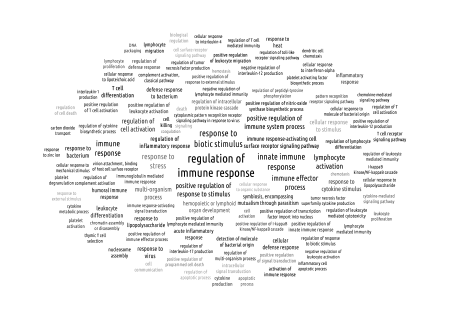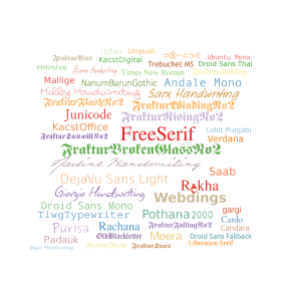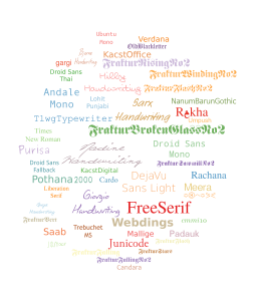tagcloud: creating tag / word clouds
Want to share your content on R-bloggers? click here if you have a blog, or here if you don't.
May I present my new package: tagcloud. Tag clouds is for creating, um, tag clouds (aka word clouds). It is based on the code from the wordcloud package, but (i) has no tools for analysing word frequencies, instead (ii) focuses on doing better tag clouds. As to (ii), it adapts to the geometry of the window better and can produce different layouts. Also, with the extrafont package, it can use just any fonts you can think of:
The general syntax is simple. The function tagcloud takes one mandatory argument, the tags to display — a character vector. In the example below, I use the font names available through the extrafont package¹, but it can be anything.
library( extrafont ) tags <- sample( fonts(), 50 ) tagcloud( tags ) dev.copy2pdf( file= "sample1.pdf", out.type= "cairo" )
Note the use of cairo in the above, otherwise the PDF does not include the fonts and the result is not impressive. Here is the result:
OK, let’s add some weights and colors. Also, wouldn’t it be cool if each font name was displayed in the actual font?
weights <- rgamma( 50, 1 ) colors <- colorRampPalette( brewer.pal( 12, "Paired" ) )( 50 ) tagcloud( tags, weights= weights, col= colors, family= tags )
How about mixed vertical and horizontal tags?
tagcloud( tags, weights= weights, col= colors, family= tags, fvert= 0.5 )
The fvert parameter specifies the proportion of tags that should be displayed vertically rather than horizontally.
Or a different layout?
tagcloud( tags, weights= weights, col= colors, family= tags, algorithm= "fill" )
Tagclouds comes with additional tools. Firstly, you have editor.tagcloud — a very minimalistic interactive editor. You need to store the object invisibly returned from tagcloud:
tc <- tagcloud( tags, weights= weights, col= colors, family= tags ) tc2 <- editor.tagcloud( tc ) plot( tc2 )
With strmultline you can break up long, multi-word tags into multi-line tags:
tagcloud( strmultline( tags ), weights= weights, col= colors, family= tags )
The result is as follows (notice “Andale Mono” or “DejaVu Sans Light”):
Finally, smoothPalette makes it easy to generate a gradient from numbers. Imagine that we want to code some other numeric information (this could be a p-value, for example) with a smooth gradient from light grey (low value) to black (high value):
newvar <- runif( 50 ) colors2 <- smoothPalette( newvar ) tagcloud( tags, weights=weights, col=colors2, family= tags )
By default, smoothPalette uses a grey-white gradient, but it can actually use any kind of color palette.
1: In order to use the fonts installed on your system, you need to import them — preferably as root — using the extrafont package. At least in my Ubuntu installation you should provide the paths to where your TTF fonts are installed, for example:
library( extrafont ) font_import( paths= "/usr/share/fonts/truetype/" )
R-bloggers.com offers daily e-mail updates about R news and tutorials about learning R and many other topics. Click here if you're looking to post or find an R/data-science job.
Want to share your content on R-bloggers? click here if you have a blog, or here if you don't.







